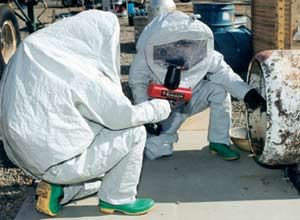By Cristi Laquer
FireRescue1 Staff
 Photo Con-Space Hazmat technicians demonstrate the EntryLink Diversity. |
Hazmat incidents can be some of the most chaotic and risky scenes first responders face.
Clear, fast communication, along with minimal exposure of personnel to the ‘hot zone’ can help reduce the inherent risk.
A new product aims to improve incident commanders’ communications with technicians in contaminated areas and provide increased visual access to the scene for those at the command post.
The SearchCam EntryLink Diversity from Con-Space Communications is a hand-held video camera built to be carried into the hot zone. It transmits live video wirelessly via up to three antennae, which are connected to a screen in the command post or command vehicle.
“Rather than send your ‘top dog’ into the fire, so to speak, he can look at a video of the area,” said Julie Nelson, vice president of marketing at the Calif.-based company.
Incident commanders and other experts who may not have the necessary training to work in contaminated areas can see what hazmat technicians are seeing and instruct them accordingly.
“The safety engineer from the plant can’t go into the hot zone,” said Nelson, “but he has the most experience, and he can say ‘ok, I want you to open up this drum or turn this valve.’”
The camera’s view is also not obstructed by hazmat protective equipment, which can fog or become dirty, or block peripheral vision.
Con-Space produces camera equipment for a variety of rescue situations, and developed the new ‘Diversity’ model based on feedback from technical responders.
In particular, wireless signals are often unreliable in the varied settings where hazmat incidents occur. “A lot of times you’ll have difficulty getting the hazmat technicians to the scene and getting the signal back to the incident commander,” Nelson said.
The new three-antenna system gives the broadcasting system a boost, she added.
The antennae can be placed up to 75 feet apart, and the system comes with a cable extension reel allowing them to be placed in advantageous locations up to 500 feet from the command post, such as on the roof of a building or at the opening of a tunnel.
In addition to broadcasting live, the device also records the incident for later review, which can aid the writing of incident reports and also be used training for training purposes.
Nelson said some tapes had even been admitted as evidence in trials.
“It’s not only for use at the time of the incident, it also allows responders to go back and review the scene later,” she said.











